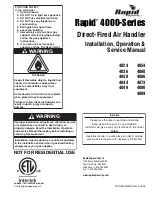
McQuay IM 487-4
107
Maintenance
Propeller Exhaust
For more information, see page 89.
Vibration Levels
Each unit as shipped is trim balanced to operate smoothly. To
provide satisfactory operation after shipping and installation,
use accepted industry guidelines for field balancing fans. See
Table 18.
Note:
Excessive vibration from any cause contributes to
premature fan and motor bearing failure. Monitor
overall vibration levels every six months of operation.
An increase in levels is an indication of potential
trouble.
Vibration Causes
1
Wheel imbalance.
a
Dirt or debris on wheel blades.
b
Loose setscrews in wheel hub or bearing-to-shaft.
c
Wheel distorted from overspeed.
2
Bent shaft.
3
Faulty drive.
a
Variable pitch sheaves—Axial and radial runout of
flanges; uneven groove spacing; out of balance. Also
similar faults in driven sheave.
b
Bad V-belts; lumpy, or mismatched; belt tension too
tight or too loose.
4
Bad bearings, loose bearing hold-down bolts.
5
Motor imbalance.
6
Fan section not supported evenly on foundation.
Periodic Service and Maintenance
1
Check all moving parts for wear every six months.
2
Check bearing collar, sheave, and wheel hub setscrews,
sheave capscrews, and bearing hold-down bolts for
tightness every six months.
Setscrews
Setscrews are used to lock bearings, sheaves, locking collars,
and fan wheels to their shafts. They must be checked
periodically to see that they have not loosened. If this is not
done, severe equipment damage could occur.
Using Table 19, check the tightness of all setscrews with a
torque wrench. Note that if the return fan bearings setscrews
must be retightened, a special procedure is required to equally
load both bearings (see “Return Fan Bearing Setscrews”
below)
.
Return Fan Bearing Setscrews
Because the return fan is mounted on a vertical shaft, the
following procedure must be used to retighten any return fan
bearing setscrews that have loosened. This procedure will
provide that both bearings are equally loaded. If one bearing is
carrying the entire weight of the fan, it could fail prematurely.
1
Loosen the fan belts.
2
Support the weight of the fan and the fan shaft with timbers
or some other suitable means (see the fan shaft support in
Figure 115).
Important:
To maintain proper drive
alignment and fan-to-tunnel clearance, the fan and shaft
must not drop at all when the setscrews are loosened in
Step 4.
3
Verify that the upper shaft collar is securely fastened to the
shaft. Check the setscrew torque.
4
Loosen the upper and lower bearing setscrews. The entire
weight of the fan and shaft is now supported by the fan
shaft support.
5
Retighten all bearings to the torque specification given in
Table 19. Remove the fan shaft support and re-tension the
belts.
Table 18: Vibration levels
Fan speed (RPM)
Vibration
800 or less
5 mils maximum displacement
801 or greater
0.20 in/sec maximum velocity
Table 19: Setscrew minimum torque specifications
Setscrew diameter (in.)
Minimum torque (ft.lb)
1/4
5.5
5/16
10.5
3/8
19.0
7/16
29.0
1/2
42.0
5/8
92.0
Artisan Technology Group - Quality Instrumentation ... Guaranteed | (888) 88-SOURCE | www.artisantg.com
Содержание RoofPak RAH 047C
Страница 118: ...McQuay IM 487 4 115 Artisan Technology Group Quality Instrumentation Guaranteed 888 88 SOURCE www artisantg com...
Страница 119: ...116 McQuay IM 487 4 Artisan Technology Group Quality Instrumentation Guaranteed 888 88 SOURCE www artisantg com...
Страница 120: ...McQuay IM 487 4 117 Artisan Technology Group Quality Instrumentation Guaranteed 888 88 SOURCE www artisantg com...



































